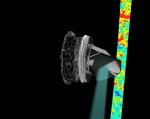Following its launch on 14 May 2009, the Planck satellite [1] has been continually observing the celestial vault and has mapped the entire sky since 13 August to obtain the first very high resolution image of the dawn of the universe. The Planck satellite has just finished its first sky coverage. The preliminary images reveal undreamed of details of emissions of gas and dust in our own galaxy. Scientists from CEA-IRFU, as part of a broad international collaboration, are currently working on the extraction and exploitation of the catalogues of objects detected by Planck. These preliminary catalogues are essential to understanding and subtracting stray foreground emissions from the background light of the universe, a fossil trace of its earliest epochs. It is also improving understanding of the formation of the largest structures in the universe, clusters of galaxies. The first catalogue will be published in January 2011. In contrast, the definitive scientific publications on the first light of the universe are not expected until the end of 2012.
Contacts: , , and
see also:
- the press release of the European Space Agency (ESA) (17 March 2010)
- the Planck public website (in French)
For more information : see the French version
[1] The PLANCK satellite is the fruit of an international collaboration with contribution from various space agencies, including the French space agency, Centre National d'Etudes Spatiales (CNES). The HFI instrument was developed by a consortium led by the French Institute of Spatial Astrophysics (IAS-CNRS) at Orsay (France). The LFI instrument was developed by a collaboration directed by the Istituto di Astrofisica Spaziale e Fisica cosmica (IASF) in Bologna (Italy). The experiment brings together hundreds of European scientists.
Written by: Jean-Marc Bonnet-Bidaud and Dominique Yvon
• Structure and evolution of the Universe › Evolution of the large structures and galaxies
• Institute of Research into the Fundamental Laws of the Universe • The Astrophysics Division (DAp) • The Electronics, Detectors and Computing Division • The Particle Physics Division
• Cosmology and Galaxy Evolution group (LCEG)
• Planck



